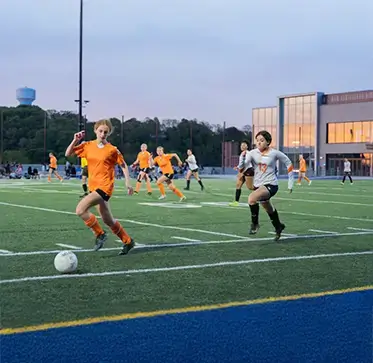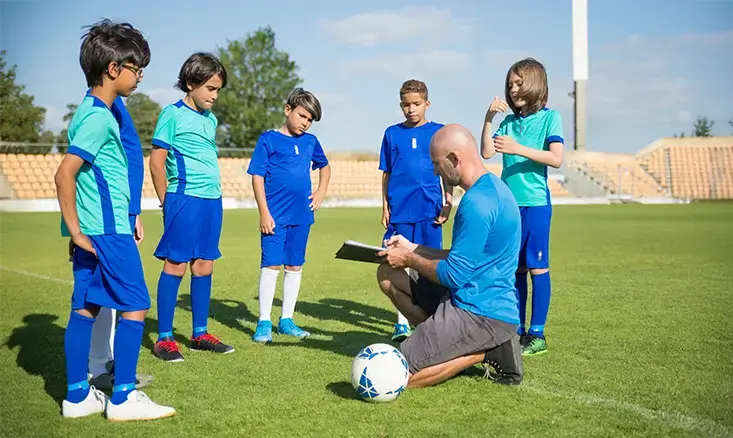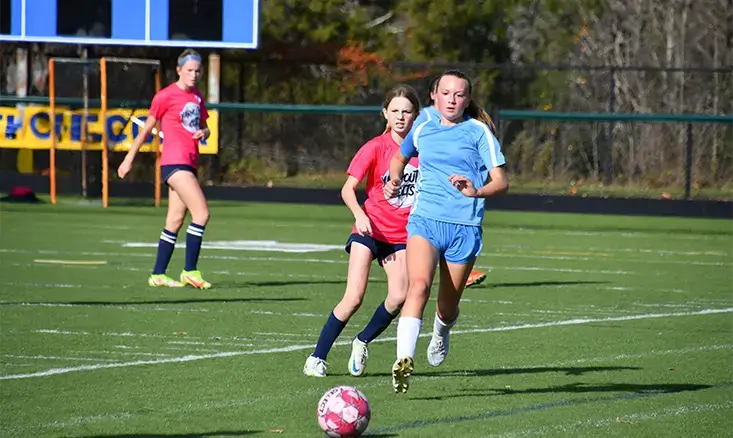Communication-Improving Exercises in Summer Camps

CRFC BLOGS
LATEST BLOGS & NEWSLETTERS
Communication-Improving Exercises in Summer Camps
Effective communication is a key to success in soccer. Whether it’s organizing defense, calling for the ball, or coordinating with teammates during set plays, clear and efficient communication on the field can make all the difference in the game. Summer Camps recognize the importance of communication and incorporate various exercises designed to help young players improve their ability to speak, listen, and work together on the field.
1. Call and Response Drills
One of the simplest yet most effective communication exercises is the call-and-response drill. During these sessions, players are paired up or grouped and instructed to call out specific commands or instructions to each other. This could include calling for the ball, directing teammates, or acknowledging a pass. The focus is on loud, clear communication that can be heard over the game’s noise.
These drills emphasize listening, as players must respond quickly to their teammates’ calls. By practicing these interactions in a controlled, low-pressure setting, players gain confidence in their verbal communication skills, which can translate to clearer communication during real matches.

2. Directional Passing
In this exercise, players are required to pass the ball to teammates based on verbal commands. Coaches will call out directions such as “left,” “right,” or “through,” and players must pass the ball accordingly. The key here is that players cannot just rely on hand signals or eye contact; they need to communicate using their voice, ensuring that their teammates understand the direction of the pass.
This drill enhances verbal and non-verbal communication, teaching players how to give and interpret directions. It also develops teamwork, as players must constantly communicate to maintain possession and execute successful passes.
3. Team Discussions and Strategy Sessions
Communication exercises aren’t limited to just physical drills—they also include strategic conversations. During team strategy sessions, players gather to discuss tactics, formations, and roles within the team. Coaches may present specific scenarios or challenges requiring players to express their ideas verbally.
These sessions teach kids to express their thoughts clearly, listen to others, and collaborate on solutions. Whether discussing how to approach an opponent or organizing a play, these group discussions promote active communication, giving players practice in constructively sharing their ideas.

4. 2v2 or 3v3 Mini-Games with Verbal Cues
Communication becomes even more critical in smaller game formats like 2v2 or 3v3 because players need to work closely together to create scoring opportunities. In these mini-games, coaches will encourage players to use verbal cues to coordinate their movements, such as calling for the ball, alerting teammates to opposing players, or giving directions on positioning.
These exercises mimic real game situations where communication needs to be quick and efficient. Players learn to shout directions, make calls under pressure, and communicate their intentions to teammates while remaining calm and composed.
5. “Shout” Dribbling Exercise
In this exercise, players must dribble through cones or around an obstacle course while giving teammates commands. Every time the ball is passed, the player must shout a specific word or phrase, such as “switch,” “through,” or “man on.” This exercise emphasizes the need to vocalize while maintaining control of the ball and focusing on the task.
The “Shout” dribbling exercise enhances verbal communication and improves players’ multitasking skills. It teaches kids how to communicate effectively while staying engaged with the game’s physical aspect, improving their soccer and social skills.
6. Partner Coaching
In this drill, players pair up and take turns being the “coach” for their partner. The coach gives clear instructions and feedback to help their partner improve their technique or positioning. This exercise develops active communication, as players must constructively share their thoughts while the “player” must listen carefully and apply the feedback.
Partner coaching allows players to step into a leadership role, encouraging them to think critically about their teammates’ actions and develop their communication abilities. It also helps them become better listeners and receivers of feedback, which is just as important as giving instructions in effective team communication.

7. Silent Communication Drills
In contrast to the previous exercises, silent communication drills help players become more habitual to non-verbal cues. In these drills, players are encouraged to communicate through body language, eye contact, and hand signals instead of speaking. This exercise helps kids understand that not all communication needs to be verbal—it’s also about how you position yourself, make eye contact, or signal to your teammate during a play.
Silent communication teaches players to read the game and anticipate their teammates’ needs, developing a deeper level of trust and understanding on the field. It also promotes creativity, as players must rely on non-verbal methods to signal their intentions.
8. “Man On” Drills
In this exercise, players practice calling out “man on” whenever an opposing player is approaching with the ball. This simple but vital communication phrase helps teammates be aware of potential threats and react quickly to defensive pressure. By repeatedly practicing this call, players become more used to constantly alerting each other during the game.
The “man on” drill highlights the importance of vocalizing threats and provides players with a tangible example of how communication can improve team defense. This exercise develops a team mentality where everyone is responsible for alerting and supporting their teammates.
9. Role-Play Scenarios
Role-play exercises allow players to simulate different game situations and practice how they would communicate in those moments. For example, one player might pretend to be the goalkeeper while others role-play defenders or attackers, calling out directions, positioning tips, and tactical advice in real time. These scenarios help kids think on their feet and practice verbalizing their ideas under pressure.
By simulating real-game situations, players can better prepare for high-pressure moments in actual games, where communication can make or break a play. Role-playing also helps young soccer players build confidence in their communication skills, knowing they have practiced speaking and listening in various contexts.

Conclusion
Campers learn how to communicate effectively on and off the field through various interactive and engaging exercises. These activities in Charlotte Rise FC Summer Camps improve players’ soccer IQ and teamwork and help them develop vital social skills, confidence, and leadership abilities.
FAQs
Why is communication important in soccer?
Communication helps players coordinate on the field, call for the ball, and organize plays. Clear communication can improve teamwork and overall game performance.
What are call-and-response drills?
These drills involve players calling out instructions like “pass” or “shoot” and responding to each other. They help kids practice speaking clearly and listening carefully.
How do small-sided games improve communication?
In 2v2 or 3v3 games, players use verbal cues to guide movements and pass the ball. These games improve quick decision-making and effective teamwork.
What is a “Man On” drill?
Players call out “man on” to alert teammates about an opponent nearby. This drill trains kids to stay aware and warn others, boosting team defense.
How do silent communication drills work?
Players practice using body language, hand signals, and eye contact instead of speaking. This builds non-verbal communication skills for better teamwork on the field.

Did you find this useful?


